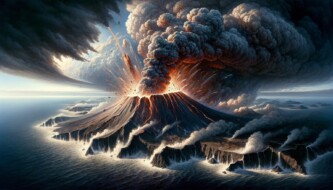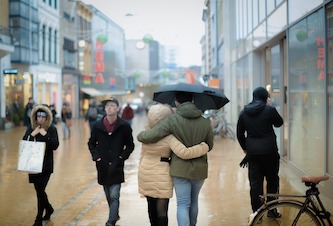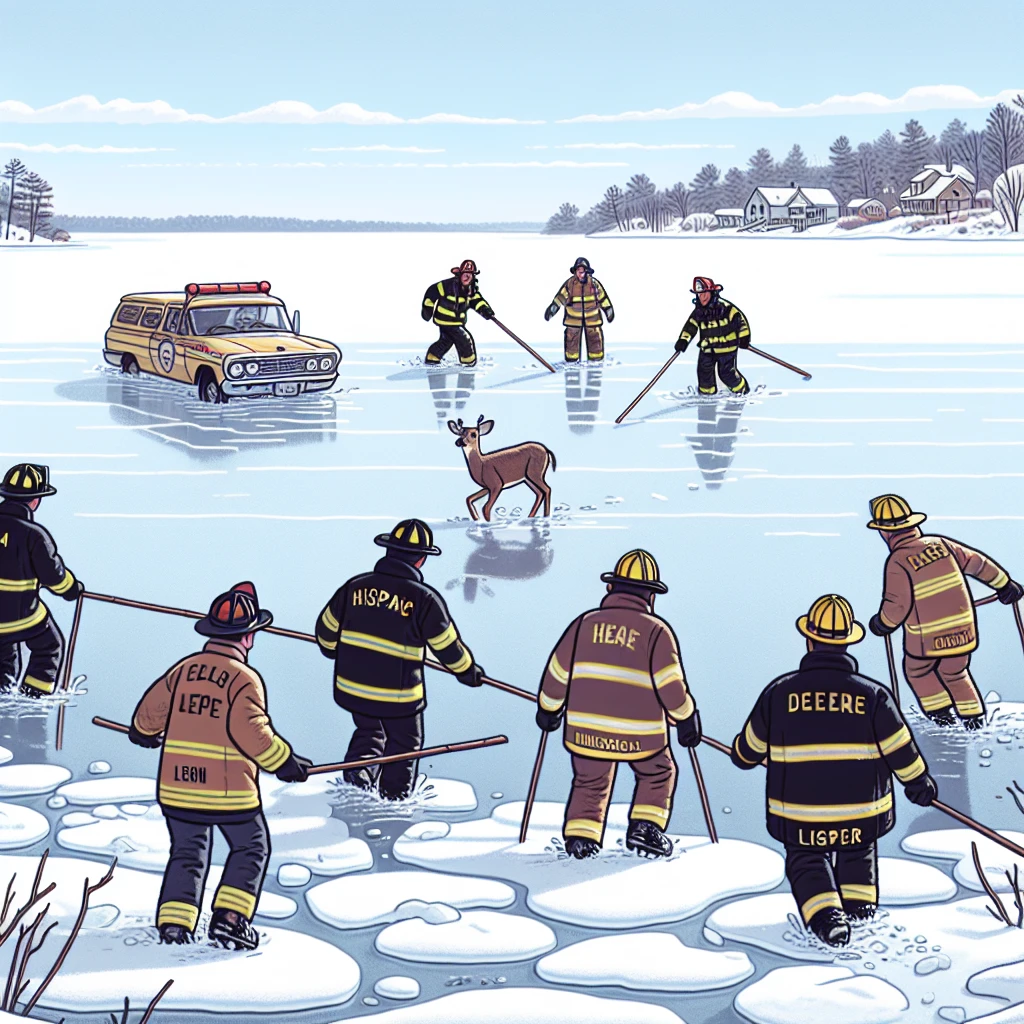An explosive eruption occurred last week at a volcano near Niijima Island in Japan, which is located about 970 km (600 miles) from Tokyo. The eruption was captured on video by Japan’s coast guard and shared on Tuesday. The footage shows volcanic rock being thrown into the sea, reaching a height of approximately 200 meters (656 feet). The volcanic island, which was formed 10 years ago, is called Niijima, meaning “new island” in Japanese.
The eruption was quite powerful, with ash and rock being ejected into the sky. This is a natural phenomenon that can occur when pressure builds up beneath the Earth’s surface and is released through a volcano. The ash and rock can travel great distances and pose a danger to nearby areas. In this case, the volcanic activity was far enough away from Tokyo to not pose a direct threat to the city.
Volcanic eruptions are not uncommon in Japan, as the country is located on the Pacific Ring of Fire, an area known for its high volcanic and seismic activity. The Ring of Fire is a horseshoe-shaped region that stretches from the west coast of the Americas to the east coast of Asia. It is home to 75% of the world’s active volcanoes and is prone to earthquakes and tsunamis.
While volcanic eruptions can be destructive and dangerous, they also play a vital role in shaping the Earth’s surface and creating new land. Volcanic activity can lead to the formation of islands, mountains, and fertile soil. It is a reminder of the powerful forces at work beneath the Earth’s crust and the dynamic nature of our planet.
In conclusion, the recent eruption at Niijima Island in Japan is a reminder of the ongoing volcanic activity in the region. While it may be a spectacle to witness, it is important to remember the potential dangers associated with volcanic eruptions. The footage captured by Japan’s coast guard provides a glimpse into the power and beauty of nature, as well as the resilience of the people living in areas prone to volcanic activity.
Original news source: Watch: Volcano in Japan spews ash, rock 200m into sky (BBC)
Listen
Slow
Normal
Fast
Group or Classroom Activities
Warm-up Activities:
– News Summary
Instructions:
1. Divide the class into pairs or small groups.
2. Give each group a copy of the article.
3. Instruct the groups to read the article and create a summary of the main points.
4. After a designated amount of time, have each group share their summary with the class.
5. Facilitate a discussion to compare the different summaries and discuss any points that may have been missed.
– Opinion Poll
Instructions:
1. Divide the class into pairs or small groups.
2. Assign each group a topic related to the article (e.g., volcanic eruptions, natural disasters, environmental impact).
3. Instruct the groups to create a set of survey questions related to their assigned topic.
4. Have each group take turns asking their survey questions to the rest of the class.
5. Encourage students to discuss and share their opinions on the topic based on the survey results.
– Sketch It
Instructions:
1. Divide the class into pairs.
2. Give each pair a sheet of paper and a pen or pencil.
3. Instruct one student in each pair to describe a scene from the article while the other student listens and sketches.
4. After a designated amount of time, have the pairs switch roles.
5. Have each pair compare their sketches and discuss how accurately they were able to depict the scene.
– Vocabulary Pictionary
Instructions:
1. Write a list of vocabulary words from the article on the board.
2. Divide the class into two teams.
3. Instruct one student from each team to come to the front of the class.
4. Call out a vocabulary word and have the two students compete to draw a picture representing the word.
5. The rest of the class must guess the word based on the drawings.
6. Award points to the team whose student successfully guesses the word.
– Speed Summarizing
Instructions:
1. Divide the class into pairs.
2. Give each pair a copy of the article.
3. Set a timer for a short amount of time (e.g., 2 minutes).
4. Instruct one student in each pair to read the article and summarize it as quickly as possible to their partner.
5. After the time is up, have the pairs switch roles.
6. Encourage students to focus on the main points and key details while summarizing.
Comprehension Questions:
1. How far is Niijima Island from Tokyo?
2. What does the footage captured by Japan’s coast guard show?
3. What causes volcanic eruptions?
4. Why are volcanic eruptions common in Japan?
5. What is the Pacific Ring of Fire?
6. What are some potential dangers associated with volcanic eruptions?
7. How can volcanic eruptions shape the Earth’s surface?
8. What does the recent eruption at Niijima Island remind us of?
Go to answers ⇩
Listen and Fill in the Gaps:
An explosive eruption occurred last week at a volcano near Niijima Island in Japan, which is located about 970 km (600 miles) from (1)______. The eruption was captured on video by Japan’s coast guard and shared on (2)______. The footage shows volcanic rock being thrown into the sea, reaching a height of approximately 200 meters (656 feet). The volcanic (3)______, which was formed 10 years ago, is called Niijima, meaning “new island” in (4)______.
The eruption was quite powerful, with ash and rock being ejected into the sky. This is a natural phenomenon that can occur when pressure builds up beneath the Earth’s surface and is released through a volcano. The ash and rock can travel great distances and pose a danger to nearby (5)______. In this case, the volcanic activity was far enough away from Tokyo to not pose a direct threat to the city.
Volcanic eruptions are not (6)______ in Japan, as the (7)______ is (8)______ on the Pacific Ring of Fire, an area known for its high volcanic and seismic activity. The Ring of Fire is a horseshoe-shaped region that stretches from the west coast of the (9)______ to the east coast of Asia. It is home to 75% of the world’s active volcanoes and is (10)______ to earthquakes and tsunamis.
While (11)______ eruptions can be destructive and dangerous, they also play a vital role in shaping the Earth’s surface and creating new land. Volcanic activity can lead to the formation of islands, mountains, and (12)______ soil. It is a reminder of the powerful forces at work beneath the Earth’s crust and the dynamic nature of our planet.
In (13)______, the recent (14)______ at Niijima Island in Japan is a reminder of the ongoing volcanic activity in the region. While it may be a spectacle to witness, it is important to remember the potential dangers associated with volcanic (15)______. The footage captured by Japan’s coast guard provides a (16)______ into the power and beauty of nature, as well as the resilience of the people living in areas prone to volcanic activity.
Go to answers ⇩
Discussion Questions:
Students can ask a partner these questions, or discuss them as a group.
1. Have you ever witnessed a volcanic eruption? If so, how did it make you feel?
2. What is the Pacific Ring of Fire and why is it prone to volcanic activity?
3. How would you feel if you lived in a region that was prone to volcanic eruptions?
4. Do you think volcanic eruptions are more destructive or beneficial to the Earth’s surface? Why or why not?
5. Have you ever visited a volcanic island or mountain? If so, what was your experience like?
6. What precautions should people take when living near a volcano?
7. How do you think volcanic eruptions impact the environment and ecosystems?
8. Do you think volcanic eruptions can be predicted accurately? Why or why not?
9. Have you ever experienced an earthquake or tsunami? If so, how did it affect you?
10. How do you think volcanic eruptions impact the economy of the affected areas?
11. What measures should governments take to protect their citizens from volcanic eruptions?
12. How do you think volcanic eruptions impact tourism in the affected areas?
13. Do you think it is worth the risk to live in an area prone to volcanic activity? Why or why not?
14. What steps can individuals take to prepare for a volcanic eruption?
15. How do you think volcanic eruptions impact the mental health and well-being of the people living in the affected areas?
Individual Activities
Vocabulary Meanings:
Match each word to its meaning.
Words:
1. eruption
2. volcano
3. rock
4. sea
5. height
6. island
7. pressure
8. danger
Meanings:
(a) A mountain or hill, typically conical, having a crater or vent through which lava, rock fragments, hot vapor, and gas are or have been erupted from the earth’s crust
(b) The measurement of how tall something is, especially from the bottom to the top
(c) The expanse of salt water that covers most of the earth’s surface and surrounds its landmasses
(d) The possibility of suffering harm or injury
(e) Solid mineral material forming part of the surface of the earth and other similar planets, exposed on the surface or underlying the soil or oceans
(f) Continuous physical force exerted on or against an object by something in contact with it
(g) A sudden and violent outburst of something
(h) A piece of land surrounded by water
Go to answers ⇩
Multiple Choice Questions:
1. Where did the recent volcanic eruption occur?
(a) Near Niijima Island in Japan
(b) Near Tokyo, Japan
(c) Near the west coast of the Americas
(d) Near the east coast of Asia
2. How far is Niijima Island from Tokyo?
(a) Approximately 200 meters (656 feet)
(b) Approximately 10 years
(c) Approximately 75% of the world’s active volcanoes
(d) Approximately 970 km (600 miles)
3. What does Niijima mean in Japanese?
(a) Volcanic eruption
(b) New island
(c) Powerful forces
(d) Resilience
4. What is the Pacific Ring of Fire known for?
(a) The formation of islands, mountains, and fertile soil
(b) The power and beauty of nature
(c) High volcanic and seismic activity
(d) The ongoing volcanic activity in the region
5. How much of the world’s active volcanoes are located in the Ring of Fire?
(a) 50%
(b) 25%
(c) 100%
(d) 75%
6. What can volcanic eruptions lead to?
(a) Destructive and dangerous situations
(b) The ongoing volcanic activity in the region
(c) The formation of islands, mountains, and fertile soil
(d) The power and beauty of nature
7. What does the recent eruption at Niijima Island remind us of?
(a) The potential dangers associated with volcanic eruptions
(b) The ongoing volcanic activity in the region
(c) The power and beauty of nature
(d) The resilience of the people living in areas prone to volcanic activity
8. What does the footage captured by Japan’s coast guard provide a glimpse into?
(a) The power and beauty of nature
(b) The ongoing volcanic activity in the region
(c) The resilience of the people living in areas prone to volcanic activity
(d) The potential dangers associated with volcanic eruptions
Go to answers ⇩
True or False Questions:
1. The eruption was captured on video by Japan’s coast guard and shared on Tuesday.
2. The volcanic activity posed a direct threat to Tokyo.
3. The volcanic island of Niijima was formed 10 years ago.
4. The eruption released ash and rock into the sky.
5. A non-explosive eruption occurred near Niijima Island in Japan.
6. Japan is not located on the Pacific Ring of Fire, known for its high volcanic and seismic activity.
7. Volcanic eruptions do not play a vital role in shaping the Earth’s surface and creating new land.
8. The volcanic rock reached a height of approximately 200 meters (656 feet).
Go to answers ⇩
Write a Summary:
Write a summary of this news article in two sentences.
Check your writing now with the best free AI for English writing!
Writing Questions:
Answer the following questions. Write as much as you can for each answer.
Check your answers with our free English writing assistant!
1. What did the recent eruption near Niijima Island in Japan look like?
2. How far away is Niijima Island from Tokyo?
3. Why are volcanic eruptions not uncommon in Japan?
4. What is the Pacific Ring of Fire?
5. What are some potential dangers associated with volcanic eruptions?
Answers
Comprehension Question Answers:
1. How far is Niijima Island from Tokyo?
Niijima Island is located about 970 km (600 miles) from Tokyo.
2. What does the footage captured by Japan’s coast guard show?
The footage captured by Japan’s coast guard shows volcanic rock being thrown into the sea, reaching a height of approximately 200 meters (656 feet).
3. What causes volcanic eruptions?
Volcanic eruptions are caused by the build-up of pressure beneath the Earth’s surface, which is released through a volcano.
4. Why are volcanic eruptions common in Japan?
Volcanic eruptions are common in Japan because the country is located on the Pacific Ring of Fire, an area known for its high volcanic and seismic activity.
5. What is the Pacific Ring of Fire?
The Pacific Ring of Fire is a horseshoe-shaped region that stretches from the west coast of the Americas to the east coast of Asia. It is known for its high volcanic and seismic activity, and is home to 75% of the world’s active volcanoes.
6. What are some potential dangers associated with volcanic eruptions?
Some potential dangers associated with volcanic eruptions include the ejection of ash and rock, which can travel great distances and pose a danger to nearby areas. Additionally, volcanic eruptions can cause lahars (mudflows), pyroclastic flows, and volcanic gases, which can be harmful to human health.
7. How can volcanic eruptions shape the Earth’s surface?
Volcanic eruptions can shape the Earth’s surface by creating new land, such as islands, and by forming mountains. Volcanic activity can also lead to the deposition of fertile soil, which can be beneficial for agriculture.
8. What does the recent eruption at Niijima Island remind us of?
The recent eruption at Niijima Island reminds us of the ongoing volcanic activity in the region and the potential dangers associated with volcanic eruptions. It also highlights the power and beauty of nature, as well as the resilience of the people living in areas prone to volcanic activity.
Go back to questions ⇧
Listen and Fill in the Gaps Answers:
(1) Tokyo
(2) Tuesday
(3) island
(4) Japanese
(5) areas
(6) uncommon
(7) country
(8) located
(9) Americas
(10) prone
(11) volcanic
(12) fertile
(13) conclusion
(14) eruption
(15) eruptions
(16) glimpse
Go back to questions ⇧
Vocabulary Meanings Answers:
1. eruption
Answer: (g) A sudden and violent outburst of something
2. volcano
Answer: (a) A mountain or hill, typically conical, having a crater or vent through which lava, rock fragments, hot vapor, and gas are or have been erupted from the earth’s crust
3. rock
Answer: (e) Solid mineral material forming part of the surface of the earth and other similar planets, exposed on the surface or underlying the soil or oceans
4. sea
Answer: (c) The expanse of salt water that covers most of the earth’s surface and surrounds its landmasses
5. height
Answer: (b) The measurement of how tall something is, especially from the bottom to the top
6. island
Answer: (h) A piece of land surrounded by water
7. pressure
Answer: (f) Continuous physical force exerted on or against an object by something in contact with it
8. danger
Answer: (d) The possibility of suffering harm or injury
Go back to questions ⇧
Multiple Choice Answers:
1. Where did the recent volcanic eruption occur?
Answer: (a) Near Niijima Island in Japan
2. How far is Niijima Island from Tokyo?
Answer: (d) Approximately 970 km (600 miles)
3. What does Niijima mean in Japanese?
Answer: (b) New island
4. What is the Pacific Ring of Fire known for?
Answer: (c) High volcanic and seismic activity
5. How much of the world’s active volcanoes are located in the Ring of Fire?
Answer: (d) 75%
6. What can volcanic eruptions lead to?
Answer: (c) The formation of islands, mountains, and fertile soil
7. What does the recent eruption at Niijima Island remind us of?
Answer: (b) The ongoing volcanic activity in the region
8. What does the footage captured by Japan’s coast guard provide a glimpse into?
Answer: (a) The power and beauty of nature
Go back to questions ⇧
True or False Answers:
1. The eruption was captured on video by Japan’s coast guard and shared on Tuesday. (Answer: True)
2. The volcanic activity posed a direct threat to Tokyo. (Answer: False)
3. The volcanic island of Niijima was formed 10 years ago. (Answer: True)
4. The eruption released ash and rock into the sky. (Answer: True)
5. A non-explosive eruption occurred near Niijima Island in Japan. (Answer: False)
6. Japan is not located on the Pacific Ring of Fire, known for its high volcanic and seismic activity. (Answer: False)
7. Volcanic eruptions do not play a vital role in shaping the Earth’s surface and creating new land. (Answer: False)
8. The volcanic rock reached a height of approximately 200 meters (656 feet). (Answer: True)
Go back to questions ⇧













